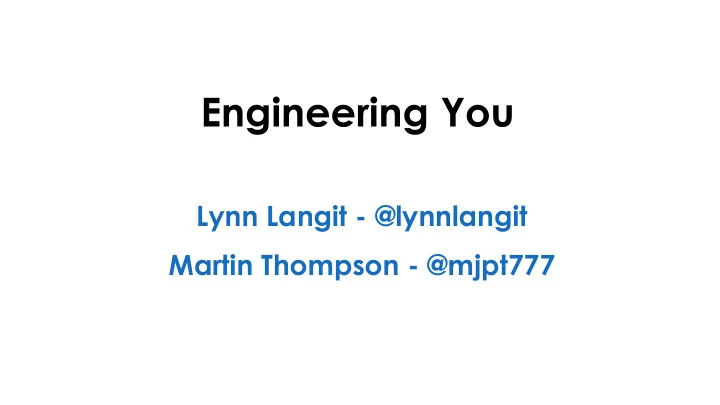

Engineering You Lynn Langit - @lynnlangit Martin Thompson - @mjpt777
“ A software system can best be designed if the testing is interlaced with the design, instead of being used after the design” - Who and When???
“ A software system can best be designed if the testing is interlaced with the design, instead of being used after the design” - A. J. Perlis (1968)
How many generations of programmers have we?
ISO 9001/27001 CMM
Engineering
The term Engineering is derived from the Latin ingenium , meaning " cleverness " and ingeniare , meaning " to contrive, devise ". Source: Wikipedia
Circa 1300 “ One who operates an engine ” , where engine is a military machine such as a catapult. Source: Wikipedia
Later the term “ Civil Engineering ” was introduced to cover those specialising in non-military projects Source: Wikipedia
Engineers must work within constraints. Constraints may include available resources, physical, imaginative or technical limitations, flexibility for future modifications and additions, and other factors, such as requirements for cost, safety, marketability, productivity, and serviceability. By understanding the constraints, engineers derive specifications for the limits within which a viable object or system may be produced and operated. Source: Wikipedia
Engineers must work within constraints. Constraints may include available resources, physical, imaginative or technical limitations, flexibility for future modifications and additions, and other factors, such as requirements for cost, safety, marketability, productivity, and serviceability. By understanding the constraints, engineers derive specifications for the limits within which a viable object or system may be produced and operated. Source: Wikipedia
Engineers must work within constraints. Constraints may include available resources, physical, imaginative or technical limitations, flexibility for future modifications and additions, and other factors, such as requirements for cost, safety, marketability, productivity, and serviceability. By understanding the constraints, engineers derive specifications for the limits within which a viable object or system may be produced and operated. Source: Wikipedia
Engineers must work within constraints. Constraints may include available resources, physical, imaginative or technical limitations, flexibility for future modifications and additions, and other factors, such as requirements for cost, safety , marketability, productivity, and serviceability. By understanding the constraints, engineers derive specifications for the limits within which a viable object or system may be produced and operated. Source: Wikipedia
Engineers must work within constraints. Constraints may include available resources, physical, imaginative or technical limitations, flexibility for future modifications and additions, and other factors, such as requirements for cost, safety, marketability, productivity, and serviceability. By understanding the constraints, engineers derive specifications for the limits within which a viable object or system may be produced and operated. Source: Wikipedia
“Software Engineering”?
http://dl.acm.org/citation.cfm?doid=363717.363722
http://homepages.cs.ncl.ac.uk/brian.randell/NATO/nato1968.PDF
The design process is an iterative one: 1. Flowchart until you think you understand the problem. 2. Write code until you realize that you don’t. 3. Go back and re-do the flowchart. 4. Write some more code and iterate to what you feel is the correct solution.
I just want to make the point that reliability really is a design issue , in the sense that unless you are conscious of the need for reliability throughout the design, you might as well give up .
The good systems that are presently working were written by small groups . More than twenty programmers working on a project is usually disastrous.
Another interesting concept we might apply is that used in the Air Force, to fly a number of hours each month, in order to retain one’s ‘wings’ .[…] In a situation where code actually has to be produced, nobody should be allowed in the system who doesn’t write some given number of lines of code per month .
http://www.cs.utexas.edu/~EWD/transcriptions/EWD10xx/EWD1036.html On the cruelty of really teaching computing science - Edsger W. Dijkstra
Radical Novelty
One has to approach the radical novelty with a blank mind, consciously refusing to try to link it with what is already familiar, because the familiar is hopelessly inadequate.
Earlier scientific examples are the theory of relativity and quantum mechanics; later technological examples are the atom bomb and the contraceptive pill.
Divide and Rule Decomposition on an unprecedented scale
Amplification of Changes Changing a single bit can have the most drastic consequences
We are all a product of our own experiences
Uncomfortable Truth
Learning What? Where? How?
What should you learn? Algorithms & Data Structures
What should you learn? Algorithms & Data Structures Design Fundamentals
What should you learn? Algorithms & Data Structures Design Fundamentals Programming Paradigms
What should you learn? Algorithms & Data Structures Design Fundamentals Programming Paradigms Decomposition & Abstraction
What should you learn? Algorithms & Data Structures Design Fundamentals Programming Paradigms Decomposition & Abstraction Mathematics
What should you learn? Algorithms & Data Structures Design Fundamentals Programming Paradigms Decomposition & Abstraction Mathematics Communications*
Monolith
From where can we learn? Personal Practice
From where can we learn? Personal Practice People & Teams
From where can we learn? Personal Practice People & Teams Research Papers
From where can we learn? Personal Practice People & Teams Research Papers Reading Code
From where can we learn? Personal Practice People & Teams Research Papers Reading Code Projects – Tackle Unknowns First
From where can we learn? Personal Practice People & Teams Research Papers Reading Code Projects – Tackle Unknowns First Online Resources
How can we learn? Automate Repetitive Tasks
How can we learn? Automate Repetitive Tasks Focus on Feedback Cycles
How can we learn? Automate Repetitive Tasks Focus on Feedback Cycles Experimentation
How can we learn? Automate Repetitive Tasks Focus on Feedback Cycles Experimentation Measure
How can we learn? Automate Repetitive Tasks Focus on Feedback Cycles Experimentation Measure Apply Scientific Honesty
How can we learn? Automate Repetitive Tasks Focus on Feedback Cycles Experimentation Measure Apply Scientific Honesty Revisit & Refine
“What can go wrong?”
25% Ignored Errors
In Closing…
Thank You! Lynn Langit - @lynnlangit Martin Thompson - @mjpt777
Recommend
More recommend